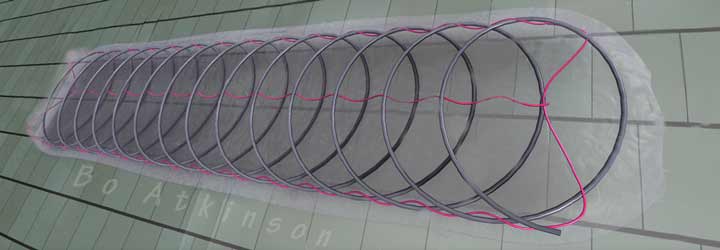
Here are some competitive, low cost water heater concepts. These are based on decades of my own experience and experimentation. Trickling small amounts of cold water through these solar-collectors can gradually fill a hot water tank. In the simplest system, heated water can be used directly. Where plumbing codes require, use of garden-hose fittings (instead of permanent fittings), might provide compliance.

Picture above is an example of very simple solar water heating, positioned on a roof. For cooler climates, it is enclosed in a plastic envelope to greatly increase heating. Widely available, black PE plastic tubing is generally the lowest cost tubing or pipe. It comes in 100 ft rolls, a random length preferred by distributors. The smallest diameter is usually half inch which is the easiest to form.
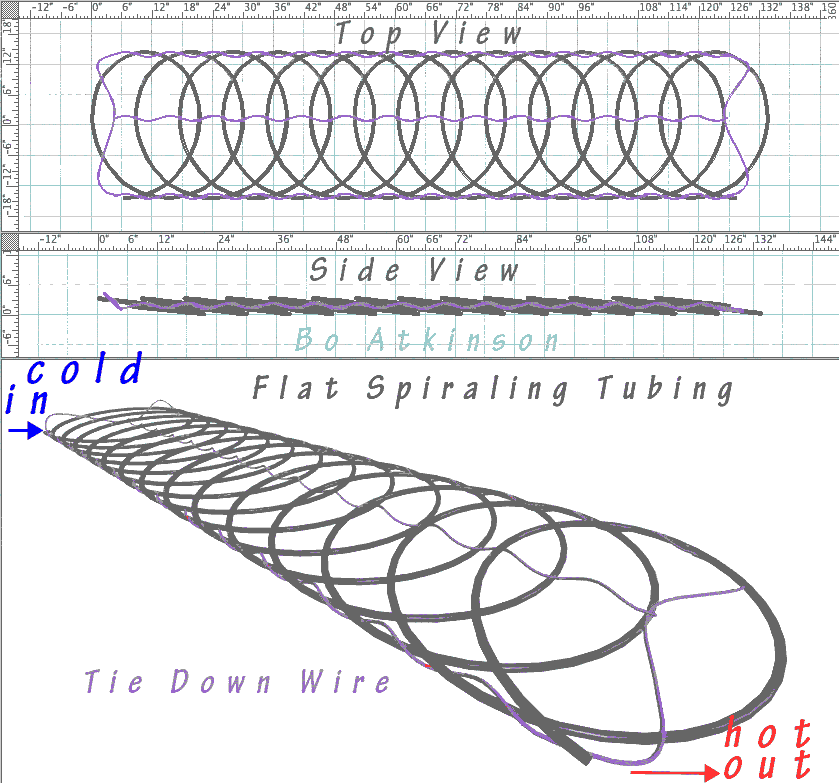
Picture above is a 3d CAD model of full 100 ft roll of 1/2" black plastic tubing. (Water content would amount to about 1.57 gallons and weigh under 13 lbs). Multiple sets of tubes can be combined to provide larger capacity.
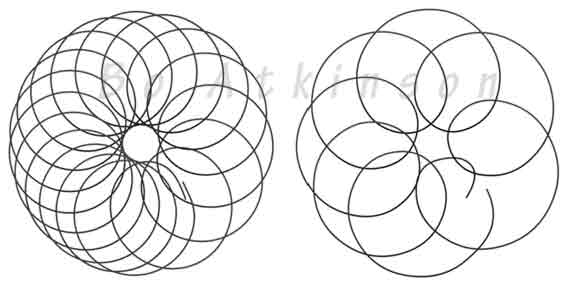
Nice flower patterns are also fairly easy to shape up wire together (or weave together). Flower shapes might add decorative flare.
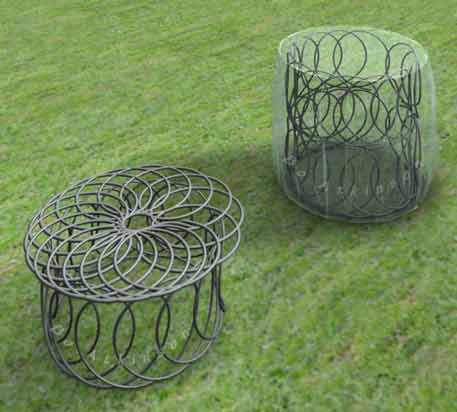
Above picture models one inch black plastic tubing. Three dimensional shaping of flat spiraling coils can integrate function and form. Two functions built into single products, table? Sauna? (Heat empty tubing in the sun, covered for greater heating. Then bending soften plastic around other objects.)
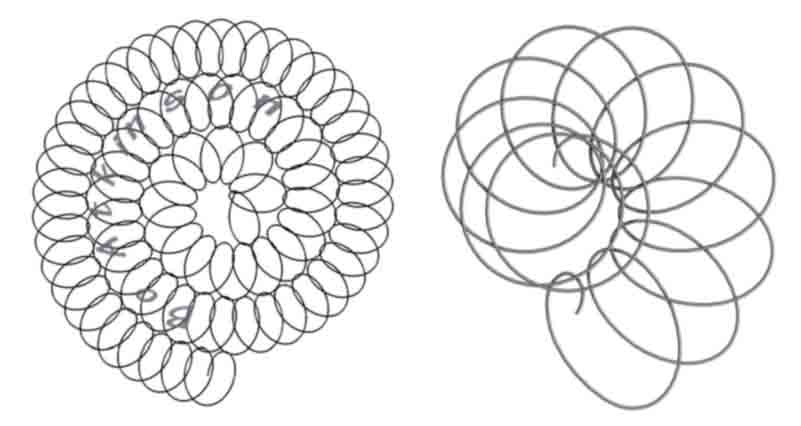
Above : The 'nautilus' spiral would need more than a 100 ft. I have found 3000 ft rolls of quarter inch black plastic sold by irrigation suppliers. (I'll be trying this here). Quarter inch tubing is easy as rope to bend. Durable tying material is recommended. The simpler 'comma' shape is to suggest abstract shapes are easy.
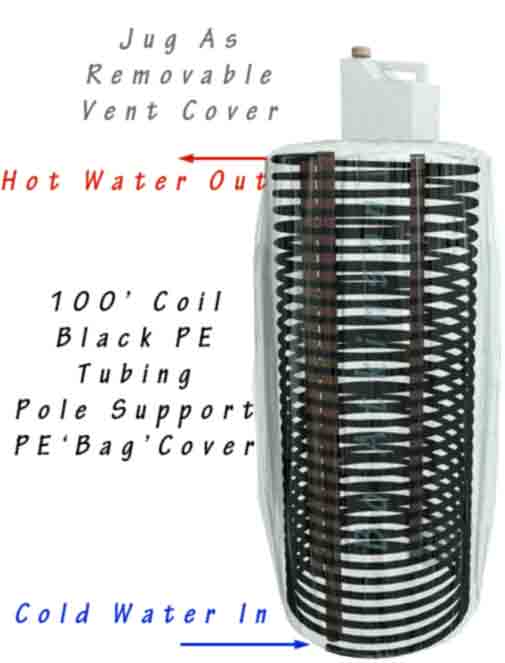
Above picture is another example of a 100 ft, one inch diameter tubing. Tubing comes as coils. So it could be fairly easy to 'un-spring' a new roll and tie to a set of poles. The enclosure could also serve as a drier for garden greens, (parsley, mint, etc...) An empty jug on top might provide easy access as well as a smaller space for smaller drying batches. A coil with cold water will 'sweat', meaning that air is dehumidified, within the (slowly drafted) enclosure.
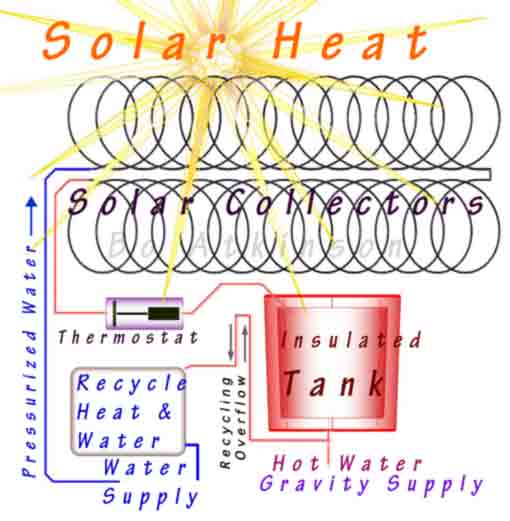
Where codes permit, a more elaborate system can be built in to a home. Here in rural Maine, common sense systems are allowed in an existing home. Similar systems have actually benefited countless individuals worldwide. This page covers my efforts during the 1980s. Public health and safety is important. An existing, officially approved, waste water system and water source, are assumed. (One must comply with their own local authorities before any installation of permanent construction). Here is one more link to an article i wrote in the 1990s.
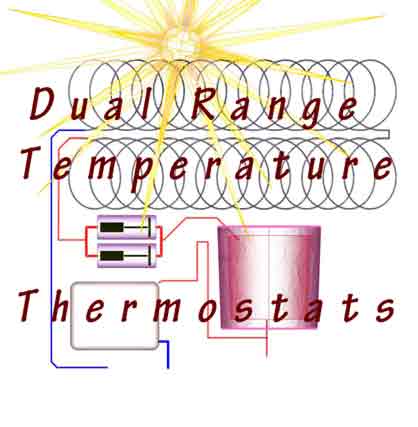
The picture above shows 2 thermostats, while the previous picture showed one thermostat. Thermostats can provide precise ranges for water temperatures, (based on installation-site characteristics). One can determine one's budget and preferred temperature range-- Customize the size or extent of the collectors, their placement and effectiveness. Engineering itself deserves a lot of information input, (before a fully satisfying combination is determined). Yet desperation has also allowed moderated levels of water heating, for those without better options. Dual thermostats are especially desirable when heat collection varies periodically and system where simplified automation is desirable. I can attest, however, that for lack of budgeting, my own system has generally used no thermostats, because the temperature range of interest generally has no market (no buyers). I tried a few but decided dual, quad or 8-thermostats, each with a tap might be needed to better target needs. Instead, (on shoe string budget here), a simple on-off valve is opened around 10AM and shut just before dusk-- Naturally, the schedule is sometimes forgotten, with cool water infiltrating-- Resulting luke warm water has typically been used for clothes washing, to get rid of it without waste. I applied the same system concept to my wood fired furnace system. We have used variations on the basics for more than 2 decades (as of 2010). The point is that low impact on the environment can be achieved at low costs. Hard times need not restrict water heating. Minimal consumerism can provide the essentials of life. We integrated a solar attic with greenhouse which simplified our struggle and saves money.
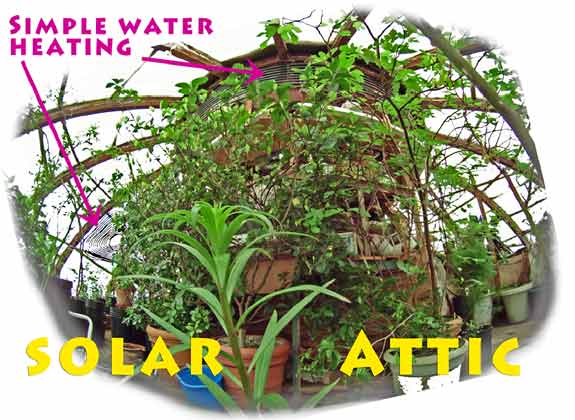
Cold water storage likewise deserves a gravity feed tank for backup.
My feeling is that a parallel water system could be added along side of existing pressurized AC-based water systems. I've used gravity tanks since the 1980s. I would expect code enforcers might not object to parallel systems, where, in the worst case if one attached only garden hose fixtures, as for emergency backup. It is important to keep sun light out of the tanks to prevent algae growth. I keep my tanks in the 'attic'.
Gravity flow tanks might gradually be thoroughly upgraded to local code which usually does mean hiring a plumber. If a free-thinking-contractor can be found, ha. As 'professionals' are typically straightjacketed with code interpretation and rarely see the tidal wave of global changes, looking ahead. Plumbers would rarely see the importance of parallel backup systems.
I actually have upgraded towards full ability to pump from a deep well in case of droughts, power outages, etc... One has to start with one's own specific locality, combined with tech studies, before designing for their own needs and budget. There are countless contexts and caveats, but gravity water tanks are not hard to start with, now that we pass the eleventh hour global changes.
If a common shut-off float-valve is used to fill the cold tank, it will continually keep the tank full. Assuming pressurized water is available. Using this water as much as needed will keep fresh water coming in automatically. When outages occur, one can keep drawing from the tank. Furthermore, i have noticed that my well water outgases if left standing and therefore tastes better. My well is rural and potable but some sort of mineral seems locked within the water until pressure is equal to ambient air pressure. My water tanks also collect minerals which are easy to flush out. Separately, in some fountain jobs of mine: I have noticed that chlorine actually releases from treated city water, perhaps in a similar manner. This tank water can yet be filtered with cheaper filtering burden and associated costs.
Eyelid Hot House -- Easiest DIY ! (Do it yourself. Based of years of personal testing only
and many years of experience with common building materials.)
(A thermostatic-valve report will be added here. Encourage me to spend my time, freely offered, to updating my webpages. The struggling visionary artist needs encouragement, such as emails!)
Thermostatic-valves are sold for other uses. Mine did not last very long-- There has been too small a market to improve thermostqtic valves. Yet the concept is beautiful. I also have to confess that i removed some of them, not to replace them. Instead to turn on and off a manual valve.... Such is life the creative.
Note: These pages are placed in the public domain and are furnished "as is". The author assumes no responsibility for the use or misuse of the concepts in this series. All authorities should be satisfied first, as might be required, by relevant laws, before any building proceeds.